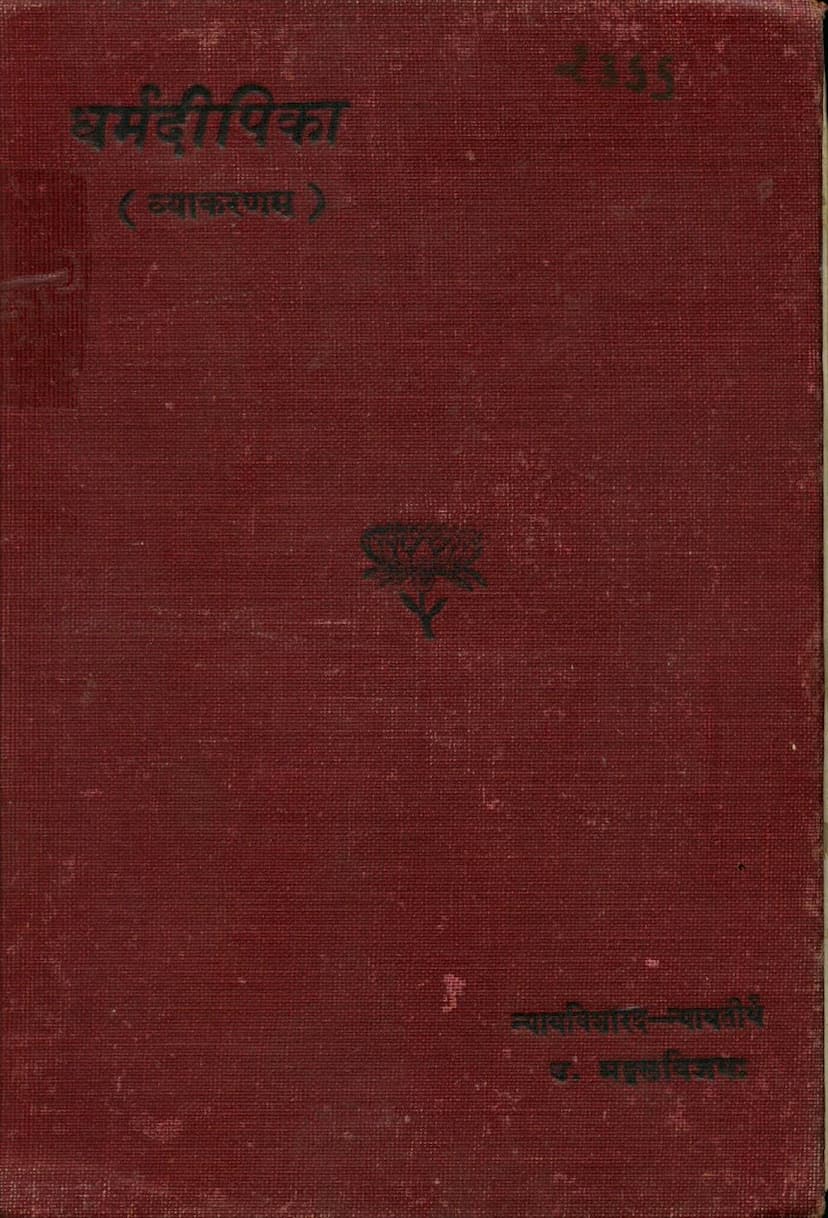Dharm Dipika Vyakaranam
Added to library: September 1, 2025

Summary
The provided text is the Jain Sanskrit grammatical work "Dharm Dipika Vyakarana" by Upadhyay Mangalvijay. The catalog link points to the Yashovijay Jain Granthmala publication.
Here's a comprehensive summary based on the provided pages:
Title: Dharm Dipika (व्याकरणम् - Grammar)
Author: Upadhyay Mangalvijay, honored with the titles "Nyayvisharad" and "Nyaytirtha."
Publisher: Yashovijay Jain Granthmala, Bhavnagar.
Date of Publication: Vira Samvat 2451 (1981 AD).
Purpose and Context: The book is a grammar (Vyākaraṇam) intended for Sanskrit learners. The author states that while many Sanskrit grammars exist, authored by both Jain and non-Jain scholars, Jain grammars are not widely known. In this context, Panini's grammar and others have gained widespread popularity. However, the author mentions that after the study and teaching of Acharya Hemchandrasuri's renowned "Siddha Hem" began at the Sanskrit Vidyalaya established by Acharya Shri Vijaydharmasuri in Kashi, the scholars of Kashi were deeply impressed by its simple style, appropriate methodology, and comprehensive presentation. This led to its prominence and spread of study.
Recognizing the extensive nature and the time required to master "Siddha Hem," and aiming to facilitate Sanskrit composition through simpler methods, the author has created this concise grammar.
Scope and Content:
The grammar is divided into two main parts: Purvardha (पूर्वार्ध) and Uttarardha (उत्तरार्ध).
Purvardha (पूर्वार्ध) - Approximately 240 pages: This part focuses on the foundational aspects of Sanskrit grammar, covering:
- Sandhi (सन्धि): Jointure of letters, including vowel sandhi (स्वरसन्धि), consonant sandhi (व्यञ्जनसन्धि), and visarga sandhi (विसर्गसन्धि).
- Prakriti Bhava (प्रकृतिभाव): Cases where sandhi rules do not apply.
- Lingani (लिङ्गानि - Genders): Six genders are discussed.
- Yushmad-Asmad Prakriya (युष्मद्-अस्मत्-प्रक्रिया): The conjugation of pronouns "you" (yushmad) and "I" (asmat).
- Avyaya Prakaranam (अव्ययप्रकरणम्): Indecclinable words.
- Stripratyaya Prakaranam (स्त्रीप्रत्ययप्रकरणम्): Feminine suffixes.
- Karakam Prakaranam (कारकप्रकरणम्): Cases and their functions.
- Samasa Prakaranam (समासप्रकरणम्): Compound words.
- Taddhita Prakaranam (तद्धितप्रकरणम्): Derivative suffixes.
- Purvaardha Sutra Anukramanika (पूर्वार्ध-सूत्रानुक्रमणिका): An index of the sutras covered in the Purvardha.
Uttarardha (उत्तरार्ध) - Approximately 500 pages: This part delves into more advanced topics, including:
- Dasha Gana (दश गण): Ten classes of roots, containing approximately 1700 roots.
- Dasha Prakriya (दश प्रक्रिया): Ten procedural topics.
- Kritya Prakriya (कृत्यप्रक्रिया): Formation of participles and other verb-derived forms.
- Uṇādi Gana (उणादिगण): The Unadi sutras, which deal with specific suffixes.
- Uttarardha Krityapratyaya Prakaranam (उत्तरकृत्प्रत्ययप्रकरणम्): Further discussion on Kṛt suffixes.
- Other Useful Topics (अन्येऽपि चोपयोगिनो विषया): This includes definitions of roots (धातुपाठ), Naya (न्याय - logic/principles), and categories of substance (द्रव्य), qualities (गुण), etc.
- Granthakṛt Prashasti (ग्रन्थकृत्प्रशस्ति): Praises for the author and supporters.
- Parishishta (परिशिष्ट): Appendices, including definitions (परिभाषाप्रकरणम्), collection of verses (सङ्ग्रहश्लोकाः), explanation of annubandha (अनुबन्धफलनिरूपणम्), classification of roots (वृत्-गणफलनिरूपणम्), and a root list (धातुपाठसूची).
- Uttarardha Sutra Anukramanika (उत्तरार्धसूत्रानुक्रमणिका): An index of the sutras covered in the Uttarardha.
- Shuddhipatraka (शुद्धिपत्रक): Errata list.
Key Features Highlighted:
- Simplicity and Clarity: The author emphasizes the simplicity of language and an effort to maintain it throughout the book for the reader's benefit.
- Comprehensive Coverage: The book aims to provide a thorough understanding of Sanskrit grammar, from basic concepts to more detailed aspects like verb roots.
- Support and Encouragement: The author expresses gratitude to those who assisted in the work, including his teacher, fellow scholars like Shrimannayavijay and Munishri Jayantvijay, and Pandit Lalchand, son of Bhagwandas Shresthi, who helped in clarifying and refining the grammar.
- Dedication: The work is dedicated to the author's Guru, Acharya Shri Vijaydharmasuri.
- Inspiration: The study and teaching of Acharya Hemchandrasuri's "Siddha Hem" served as an inspiration for this work.
Overall, "Dharm Dipika Vyakaranam" appears to be a systematic and well-structured Sanskrit grammar intended to make the study of the language accessible and efficient for learners, particularly within the Jain tradition.